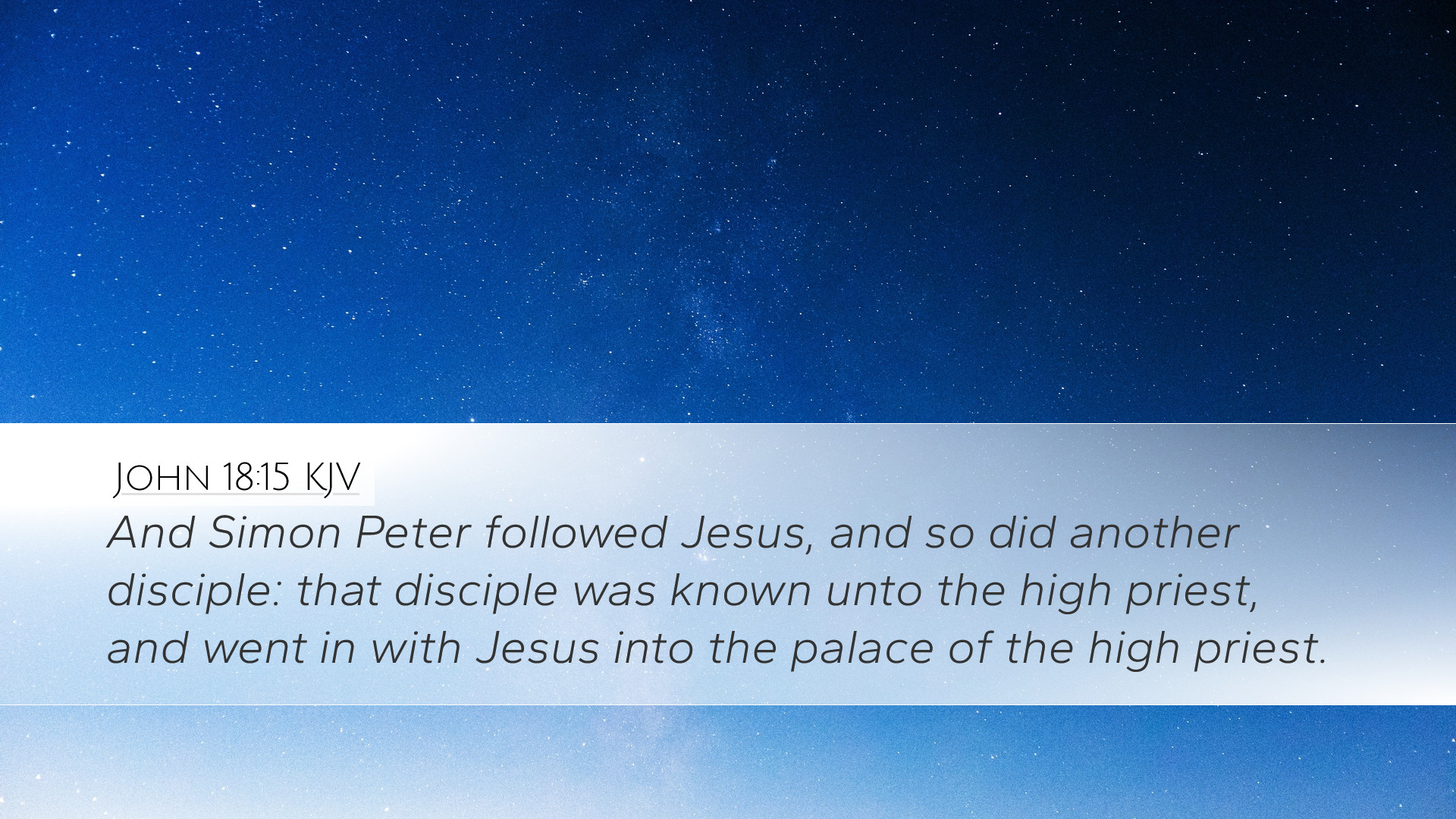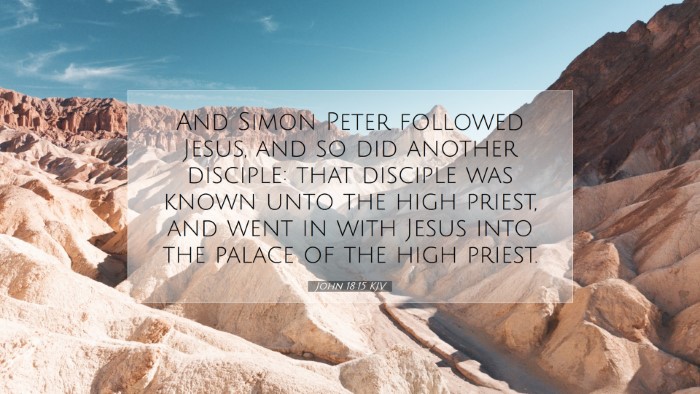Commentary on John 18:15
Verse Context: John 18:15 states, "And Simon Peter followed Jesus, and so did another disciple: that disciple was known unto the high priest, and went in with Jesus into the palace of the high priest." This passage occurs in the aftermath of Jesus' arrest and reveals key aspects related to vigilance, discipleship, and the gravity of the moment.
Insights from Matthew Henry
Matthew Henry emphasizes the significance of Peter’s following Jesus in the hour of His arrest. He notes that this act of following was one of both curiosity and loyalty, yet it foreshadows the struggles Peter would face as a disciple.
- Discipleship: Peter’s determination to follow Jesus, even at a distance, speaks volumes about the complexities of discipleship. Many believers, like Peter, desire to be close to Christ but often falter during trials.
- Connection with Another Disciple: Henry points out the mention of another disciple, likely John, accentuating the communal aspect of following Jesus. This companionship is crucial during moments of trial.
- High Priest's Palace: The high priest’s house represents the intense conflict between the values of the Kingdom and the religious authority of the day. Peter’s entrance into this space underscores the tension present as Jesus prepares for His crucifixion.
Insights from Albert Barnes
Albert Barnes offers a thorough exposition of the personalities involved and the setting of this verse. He focuses on the implications of following Jesus into a potentially hostile environment.
- Risk and Courage: Barnes highlights Peter’s courageous act. Entering the palace of the high priest is depicted as both a dangerous and noble move, illustrating that genuine discipleship often requires taking risks.
- Another Disciple: The reference to "another disciple" not only identifies John’s role but illustrates the support system among believers. Barnes draws a parallel to the importance of supporting one another through trials.
- Identification with Jesus: Entering into the hostile territory of the high priest's palace symbolizes an intimate identification with Christ. Barnes calls attention to the reality of standing with Jesus in His sufferings.
Insights from Adam Clarke
Adam Clarke shares additional layers of understanding regarding the cultural and relational dynamics at play in this verse.
- Historical Context: Clarke provides insight into the relationship between the Jewish leaders and Jesus, explaining that breaching the walls of the high priest’s palace was a significant act laden with risks for a follower of Christ.
- Character of Peter: Clarke delves into Peter’s character, noting that his impulsive spirit often leads him to act before he thinks. This gives a dual aspect of bravery and folly during this critical time in Jesus’ life.
- Symbol of Fellowship: The other disciple, often considered John, symbolizes not only fellowship but a network of fellowship that is vital in believers’ lives, especially during trials.
Theological Reflections
This verse invites a deeper theological reflection on themes such as the nature of discipleship, the call to follow Christ amidst adversity, and the essential role of community in the journey of faith.
- Nature of Discipleship: Genuine discipleship might not always mean unwavering loyalty. It can involve layers of doubt, fear, and the need for forgiveness, which is exemplified in Peter’s later denial.
- The Role of Community: The 'other disciple' emphasizes the necessity of support and fellowship among believers. The church is designed to uphold one another, especially during trying times.
- Following Jesus: Peter’s act of following Jesus into a trial reflects the cost of discipleship. It encourages believers to examine if they are prepared to endure hardships for their faith.
Practical Applications
For pastors, students, theologians, and Bible scholars, John 18:15 presents several practical applications:
- Encouragement in Trials: Pastors can encourage their congregations to follow Jesus with boldness, just as Peter did, while acknowledging that trials can lead to growth and deeper faith.
- Fostering Community: The importance of shared experiences among believers should be cultivated, especially within small groups that face challenges together.
- Reflecting on Personal Faith: Individual believers ought to engage in self-reflection regarding their personal commitment to following Jesus, and what that entails during moments of hardship.
Conclusion
John 18:15 serves as a profound reminder of the complexities of faith, loyalty, and community within the life of a believer. As believers follow Jesus through trials, they are encouraged not only to reflect on their own commitments but also to support one another in their journeys. The insights from prominent commentators illuminate these truths, offering rich theological reflections suitable for all who seek to understand the depth of Scripture.


